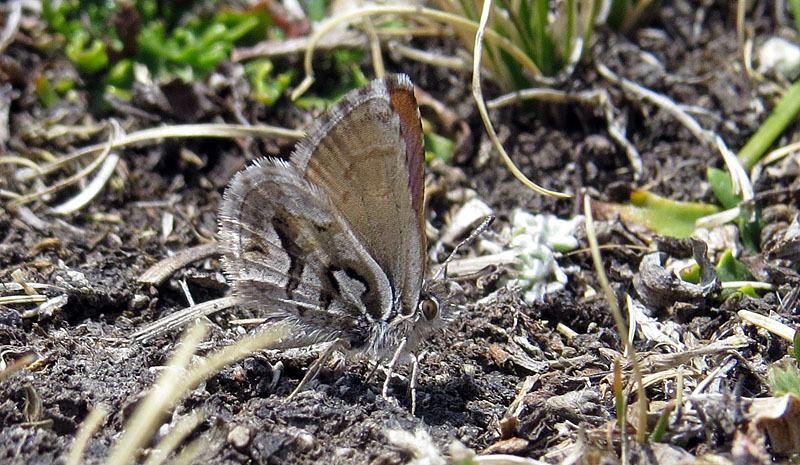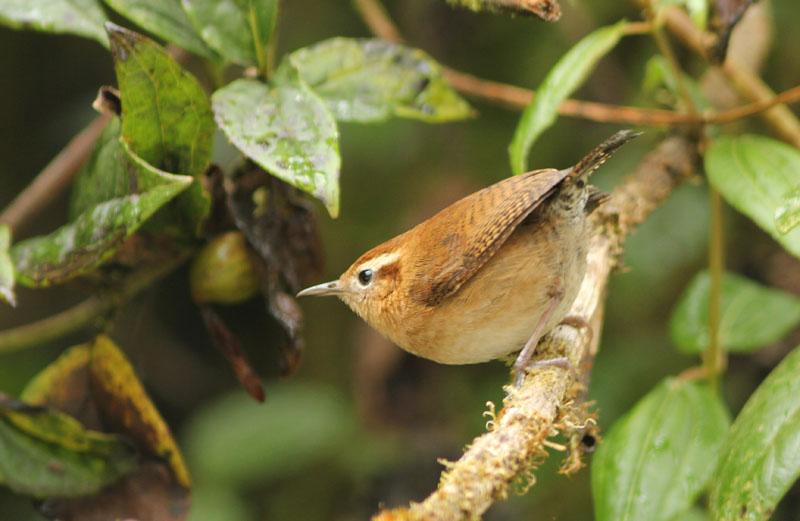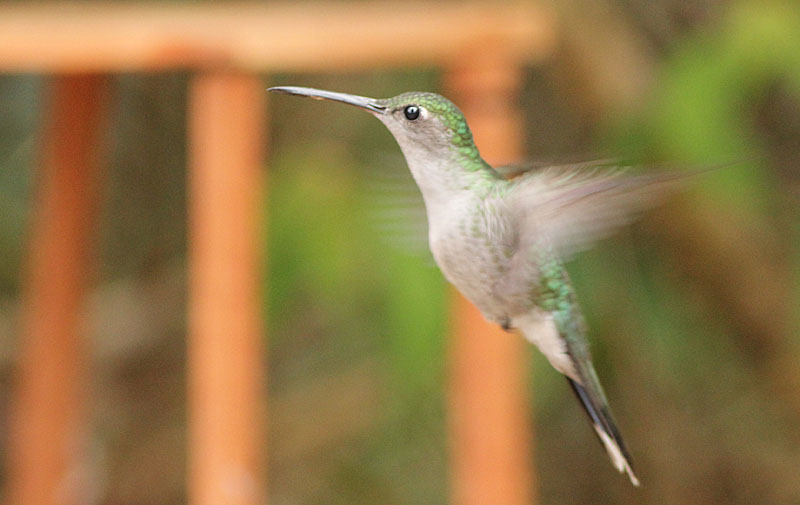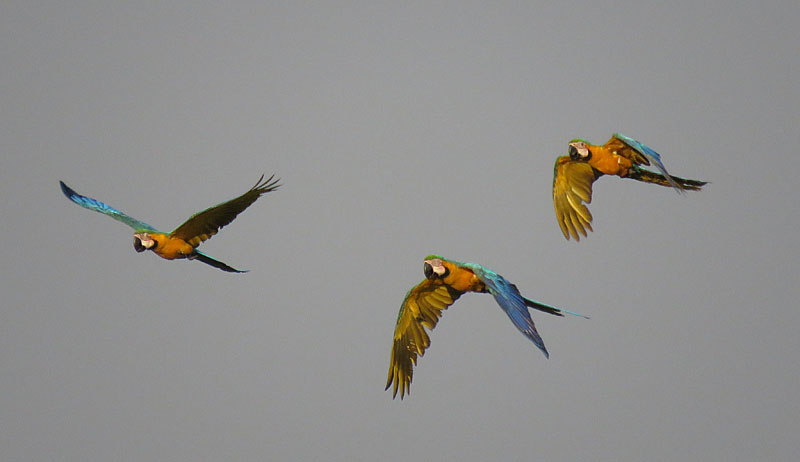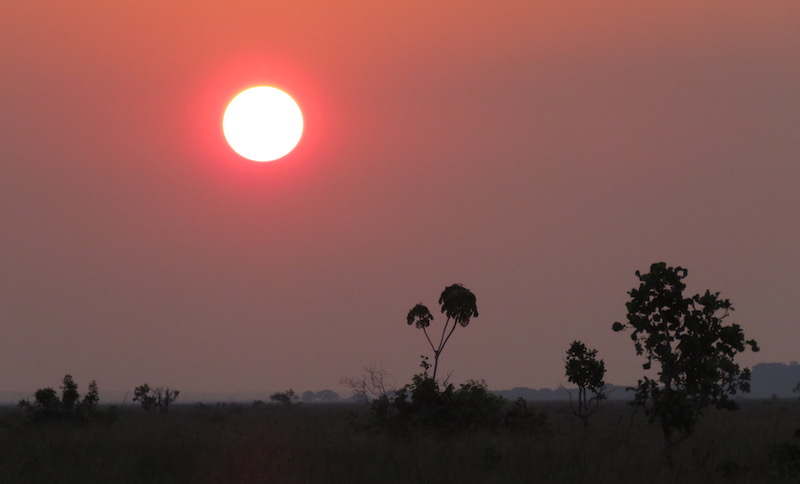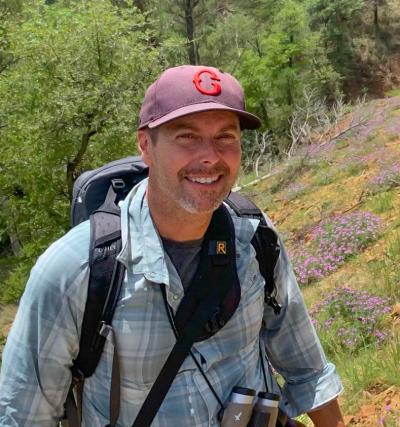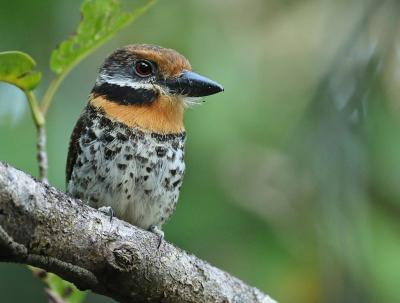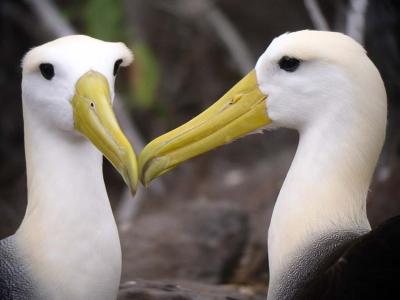Bolivia: Northern Andes, Madidi National Park, and Barba Azul
-
Oct 6-22, 2026
Rich Hoyer
Tour Price to be Determined
Tour Price to be Determined
Bolivia is a large country with many ecoregions, and this companion to our classic Bolivia tour allows you to see even more of it and the wonderful birds that call it home. We’ll visit four regions of radically different ecosystems, all farther north than our other tour. Starting with the Lake Titicaca area, we’ll bird its shores then cross the northern Andes and descend through the cloud forests on our way to the dry interior valley of Apolo, which has a whole host of special birds. We’ll then return to La Paz to take a short flight to the Amazonian lowlands where we’ll spend some time at one of Bolivia’s few ecolodges, located on the outermost ridge of the Andes—low enough to have some classic Amazonian species yet high enough to offer some respite from the tropical heat. Finally, we’ll take a private air taxi to Barba Azul Nature Reserve, a remote station located in the Llanos de Moxos, a region of seasonally flooded tropical savanna and gallery forest. After two days at bird-filled Barba Azul, famous for its conservation importance for the Blue-throated Macaw, we’ll finish with a day in Trinidad and a short internal flight to Santa Cruz de la Sierra.
Day 1: The tour begins this evening at our La Paz hotel.
Day 2: After a relaxed morning start, we’ll have an easy day to acclimate to the elevation and recover from overnight flights, but we’ll still see some exciting birds in the process, among which could be Titicaca Grebe (found only in this lake’s basin), Yellow-winged Blackbird, Many-colored Rush-Tyrant, and Wren-like Rushbird. A detour to the valley of Sorata may result in our finding the endemic Berlepsch’s Canastero and Black-hooded Sunbeam. Night at Lake Titicaca.
Day 3: If necessary, we’ll make some more birding stops along Lake Titicaca and at nearby marshes to look for waterfowl, such as Andean Goose and Yellow-billed Pintail, Chilean Flamingos, and migrant shorebirds before we start working our way into the drier, upland habitats of the Andes. Ovenbirds such as the Slender-billed Miner and tyrants such as Ochre-naped Ground-Tyrant could be found on the short grass tundra-like puna, while various small ponds and lakes should have Giant Coot, Crested Duck, and many other fascinating species. Well then cross a high pass and arrive at a stopping point part way down the Andean slope. Night in Charazani.
Day 4: We’ll complete our drive to Apolo today, passing through some mid-elevation cloud forests that are full of interesting birds. At the higher elevations, we’ll listen for the ethereal songs of Andean Solitaires, keeping our eyes on the sky for the rare White-throated Hawk and much more likely Andean Condor. As the day progresses, we’ll visit lower stretches of cloud forest with more subtropical affinities, and possibilities here include Many-spotted Hummingbird, Slaty Gnateater, Montane Foliage-gleaner, Upland Antshrike, White-rumped Hawk, the recently split Yungas Warbler, and many more. We’ll arrive at our lodging in the early evening. Night in Apolo.
Days 5–6: We’ll spend two days in this interior valley in the rain shadow of the Andes’ outlying ridges. Dry areas like this in an otherwise rain-drenched eastern slope are quite rare and host birds with isolated distributions. One of the most famous recent rediscoveries here is the endemic and far-removed subspecies of Swallow-tailed Cotinga, which some split as the Palkachupa Cotinga. We’ll make a special effort for it and also look for the rare Green-capped Tanager, a subtle beauty with a tiny distribution. In the drier areas likely species include White-eared Puffbird, Blue-crowned Trogon, Red-winged Tinamou, and Sapphire-spangled Emerald. In the taller seasonally dry forests within the Madidi National Park’s buffer zone we’ll search for the enigmatic and recently described Inti Tanager, along with White-bellied Pygmy-Tyrant, Black-bellied Antwren, and the very range-restricted Ashy Antwren. Arboreal Brasiliopuntia cacti and trees festooned with bromeliads and epiphytic staghorn ferns give this forest a fascinating and alluring aspect. Nights in Apolo.
Day 7: We’ll retrace our steps back towards La Paz, breaking the long drive in half in order to bird the moist cloud forests along the main road once again. We’ll be certain to pick up many species we missed on the way down, which could include Amazonian Umbrellabird, Yungas Warbler, and Rufous-booted Racket-tail. Night in Charazani.
Day 8: We’ll spend the early morning just outside of this high-elevation town to bird the edges of the dry scrub below the puna zone where Puna Tapaculo and Andean Hillstar are among the many possibilities. Then we’ll work our way over the broad, high pass, where we’ll concentrate on picking up some species that we may have missed on the first drive through here, with Gray-breasted Seedsnipe, Bright-rumped Yellow-Finch, Buff-breasted Earthcreeper just some of the possibilities. We’ll complete the day with a drive to La Paz. Night in La Paz.
Day 9: This morning we’ll take a 30-minute flight to Rurrenabaque, Bolivia’s gateway to Amazon Basin. From there we’ll transfer by road to the ecolodge that will be our home for the next four nights, stopping to look for birds along the way if we have time. A pond by the road is a great place to check for Hoatzin, while we’ll likely be distracted by toucans and aracaris perched in roadside trees, Roadside Hawks sitting right where they belong, family groups of Smooth-billed Anis in hedgerows, and Red-breasted Meadowlarks on fences. We’ll arrive at our lodge in time for lunch and enjoy the lovely view of the deeply layered forest right outside the dining hall. A jungle lodge on an outlying ridge of the Andes, Sadiri is a rarity in Bolivia. Amidst this perfect habitat we’ll enjoy leisurely birding while paying special attention to the range-limited species found here. The recently described Yungas Tyrannulet is unlikely to be found on any other tour’s itinerary, but more common and colorful birds such as Starred Wood-Quail and Paradise Tanager will be just as delightful. Mixed flocks pass right by our cabins, and an excellent system of forest trails and a little-traveled road pass through beautiful, pristine habitat full of potential. Night at Sadiri Lodge.
Days 10-11: We’ll have two full days of birding the trails and roads at Sadiri, allowing for afternoon siestas and chances to sit and watch the hummingbird feeders, as well a taking evening owling walks with possibilities of witnessing other nocturnal creatures such as Paca and numerous frogs. Nights at Sadiri Lodge.
Day 12: After some early morning birding at Sadiri, we’ll drive to the frontier town of Santa Rosa de Yacuma. Along the way we’ll pass by some extensive marshes and exquisite habitat, and driving nonstop will be impossible. We’ll likely see Snail Kite, Black-collared Hawk, Limpkin and many other water birds along the way, and we’ll arrive in time for our chartered air taxi. From Santa Rosa we take a 30-minute flight, passing over the enchanting landscapes of marshes, lakes, pastures, and grasslands of the Llanos de Moxos. We’ll arrive at Barba Azul Nature Reserve in time for lunch, take a siesta, and then in the afternoon make our first outing, during which we’ll likely see our first Blue-throated Macaws. Night at Barba Azul Nature Reserve.
Day 13-14: We’ll have two full days based at the reserve. We’ll prioritize several specialties, especially the namesake of the reserve, the extremely local Blue-throated Macaw. The story of the discovery of the Blue-throated Macaw’s distribution and its ongoing conservation is well known but can’t be told often enough. If not for the efforts of several conservationists in Bolivia, the species could very well be extinct in the wild, and our visit will help support the efforts to ensure its survival. There are actually six species of macaws possible here, as well as many other birds found in the tropical savanna and gallery forests, and we’ll search for specialties such as Cock-tailed Tyrant, Sharp-tailed Tyrant, Streamer-tailed Tyrant, Black-masked Finch, Long-winged Harrier, and Chimango Caracara. This region is so filled with birds, each day’s bird list will likely exceed 125 species with little effort. Nights at Barba Azul Nature Reserve.
Day 15: After a final morning of birding at the reserve we’ll continue via private air taxi to Trinidad, with some afternoon birding near town. We’ll look for the unusual and highly localized vireo that has been provisionally placed with Gray-eyed Greenlet, check the lake shore for water birds, and likely see Scarlet-headed Blackbird in the nearby marshes. Night in Trinidad.
Day 16: We’ll have most of the day based out of Trinidad to look for any birds missing from our list, and there are a few specialties more easily found here than elsewhere on our itinerary. Unicolored Thrush, an elusive endemic, is one of the more remote possibilities. If we’ve missed the Blue-throated Macaw due to unforeseen circumstances, there’s a discrete breeding population within driving distance that will be our priority. The Velvet-fronted Grackle and Plain Softtail that occur in this part of Bolivia are often considered worthy of specific status, so we’ll look for them as well. In the afternoon we’ll take a commercial flight to Santa Cruz. Night in Santa Cruz de la Sierra.
Day 17: The tour ends this morning with transfers to the international airport in Santa Cruz de la Sierra.
Note: The information presented here is an abbreviated version of our formal General Information for Tours to Bolivia. Its purpose is solely to give readers a sense of what might be involved if they took this tour. Although we do our best to make sure what follows here is completely accurate, it should not be used as a replacement for the formal document which will be sent to all tour registrants, and whose contents supersedes any information contained here.
ENTERING AND LEAVING BOLIVIA: A passport valid for at least six months after the date of your arrival and with at least one blank page for an entry stamp, and a visa are required for U.S. citizens traveling to Bolivia for any purpose. Citizens of other countries should contact their nearest Bolivia Embassy or Consulate.
Bolivia requires proof of Yellow Fever Vaccination upon application for a visa and arrival into the country.
For more information, visit the Bolivian consulate web site at http://www.boliviawdc.org/consulate/visas/tv.
COUNTRY INFORMATION: You can review the U.S. Department of State Country Specific Travel Information here: https://travel.state.gov/content/travel.html and the CIA World Factbook here: https://www.cia.gov/the-world-factbook/. Review foreign travel advice from the UK government here: https://www.gov.uk/foreign-travel-advice and travel advice and advisories from the Government of Canada here: https://travel.gc.ca/travelling/advisories.
PACE OF THE TOUR: Early mornings and full birding days will be the rule, but we always try to be back at the hotel well before dark and allow at least hour off before dinner. Sunrise is around 6:00AM. and sunset at 6:30PM. While we are driving, daily departures from the hotel are usually around 5:00AM to 5:30AM, depending on the length of the drive, and we are back to the hotel by about 4:00PM to 4:30PM. Days are long, but walking distances will be short. While at Sadiri and Barba Azul, days are more relaxed as we’ll be on foot most days and will have chances for siestas after lunch as well as the option to quit earlier in the morning. However, keep in mind we’ll be on our feet for more hours of the day, which some find even more tiring despite the time off for siestas.
During the first part of the tour, birding will be on dirt or paved roadsides, though we’ll occasionally want to walk off the road in the tundra-like puna, which will have some uneven footing and perhaps some slopes. Such off-road walks will be optional. At Sadiri and Barba Azul, the farthest we walk from the lodge is about a mile and a half. Walking sticks are highly recommended.
Everything at Sadiri is hilly – it’s located on the crest of the outermost ridge of the Andes. The cabins farthest from the dining hall require ascending about 175 steps over 200 meters to get to the dining hall. Some trails have short steep sections, and having a hiking stick will be useful for many of these sections. Barba Azul is very flat, but the trail surface is often very uneven with roots or dirt clods. There is also much less shade there, so be prepared to have a hat and carry water.
Throughout the tour we do lots of standing and watching, and we generally move very slowly. If this tends to tire your lower back, a small, lightweight travel stool that you can carry with a strap over your shoulder would be useful.
HEALTH: The Centers for Disease Control and Prevention (CDC) recommends that all travelers be up to date on routine vaccinations. These include measles-mumps-rubella (MMR) vaccine, diphtheria-tetanus-pertussis vaccine, varicella (chickenpox) vaccine, polio vaccine, and your yearly flu shot.
They further recommend that most travelers have protection against Hepatitis A and Typhoid.
The most current information about travelers’ health recommendations can be found on the CDC’s Travel Health website here: https://wwwnc.cdc.gov/travel/destinations/list
Malaria: Malaria is very rare where we are. Please consult your physician as to the advisability of taking a prophylaxis.
Please contact your doctor well in advance of your tour’s departure as some medications must be initiated weeks before the period of possible exposure.
Leishmaniasis: Tiny phlebotomine flies (technically called sand flies but not related to the gnats that bite in sandy areas) carrying the Leishmania parasite do exist at lower elevations in Bolivia, but the risk is not high, as we rarely see the insect, and not all are vectors. If the insect is seen (it looks like a tiny, pale mosquito and is active only from dawn to dusk), the leader will point it out; steps to avoid exposure are the same as for mosquitoes.
Elevation: Highly recommended as a prophylaxis for altitude sickness is Acetazolamide, known as the prescription drug Diamox in the United States. Please consult your doctor if you think high elevation may be an issue for you. We will be going over a pass of 15,230 feet (4640 meters) on two days, although if we stop there we will do only a bit of walking on the roadside. But keep in mind that El Alto International airport is the highest in the world at 13,325 feet (4062 m), and our hotel is at 12,630 feet (3850 m). At these altitudes, many people experience nothing more than lightheadedness and a need to take deeper breaths with only a little exertion; some just find it exhilarating. But some experience a delayed effect of nausea and headache which will eventually disappear after you acclimate in several hours. While these effects can be mitigated by taking aspirin or ibuprofen and drinking plenty of water, taking Acetazolamide the day before you arrive in Bolivia is a good way to avoid them altogether.
Insects: Mosquitoes will generally not be problem in the highlands, but there may be small biting gnats, especially in the cloud forest when it is sunny. Sadiri is in foothill forest, so mosquitoes or sand flies could be here in the evenings, and one should be protected. There are few biting insects at Barba Azul until dusk, when close to the marshy areas many mosquitos emerge; these do not carry any diseases here, but one should be prepared; the best defense against any insects is to wear long-sleeved shirts and pants, especially in the evenings and to use repellent on exposed skin.
In the Neotropic lowlands and humid areas, chiggers are the main invertebrate nuisance, causing itchy and often persistent welts, usually on ankles and waistbands. These appear a full day after the nearly microscopic critters have imbibed their fill of externally digested epidermis and have fallen off otherwise undetected. The best prevention against chiggers (and ticks) is to treat your clothing with permethrin one to a few days before you leave home. This non-staining, odorless chemical is non-toxic to humans and protective on clothing through several launderings. Camping supply and drug stores sell sprays containing 0.5% permethrin, while online sources also offer pump sprays as well as a more economical 10% concentrate which you dilute and then treat clothing (pants, shirts, and sock cuffs – no underwear) by soaking it in a large bag and then hanging it out to dry; be sure to look into this option well in advance of the tour, especially if you live in a cooler, moister climate.
Smoking: Smoking and vaping is prohibited in the vehicles or when the group is gathered for meals, checklists, etc. If you are sharing a room with a nonsmoker, please do not smoke in the room. If you smoke in the field, do so well away and downwind from the group. If any location where the group is gathered has a stricter policy than the WINGS policy, that stricter policy will prevail.
Miscellany: One can never completely escape the risk of parasites or fungal infections. Please consult with your physician. We avoid tap water; filtered and bottled water are readily available. Gastrointestinal problems are always a possibility while traveling; you may want to bring Imodium or some other reliable anti-diarrhea medication. You also may wish to bring a broad-spectrum antibiotic in case of stubborn bacterial infections. Sun and UV exposure in the higher elevations can be very intense. Please bring adequate protection, including a sun hat and a strong sun screen of at least 15 rating. Snakes of any kind are rarely encountered in the tropics, and we will be lucky to see one. Furthermore, venomous species are in the minority in the Americas, and we spend very little time on trails in the humid lowlands where one would have the greatest chance of finding one. Still, it’s always something to keep in mind.
CLIMATE: We will be nearing the end of the dry season and at the beginning of the rainy season, so weather is highly unpredictable and according to elevation quite variable. It will likely be mostly sunny and hot in the lowlands and cool with cold mornings in the high elevations. The highest elevations will likely be sunny and dry with morning temperatures around freezing. The cloud forest areas could get persistent to intermittent rain, mist, or fog at any time, and the approach of a late cold front could alter things rapidly anywhere, bringing similar weather to every elevation, where even in the tropical lowlands low temperatures could drop to the upper 40’s and highs only into the 60’s. Otherwise temperatures should stay between 50-90?F for most of the tour; warmer temperatures are possible at the lowest elevations during the latter half of the tour.
ACCOMMODATIONS: We’ll be staying in hotels and lodges with a wide variety of comfort levels, some excellent and modern, others basic but clean and safe. Most offer rooms with private bathrooms and all have hot water showers (usually heated with an electric coil at the shower head, some with gas). At Apolo we’ll be staying in a monastery; rooms are very simple but clean and have private bathrooms
Sadiri has six large, very nice double-occupancy cabins, each with a private bathroom, so single rooms may be available but not be guaranteed here, depending on the group size and makeup. The cabins are quite spread out on a complex of branching trails; the farthest is about 200 meters from the dining hall and down a series of 150+ steps, so this place isn’t ideal for anyone with weak knees or who has trouble with steps.
Barba Azul has four rustic, solidly-built double cabins with private bath and four dorm-style rooms with two shared bathrooms. Depending on group size, doubles will be given preference in the cabins, and anyone requesting single supplement may be in the dorms. The cabins are very spread out and private with amazing views of the Omi River marsh right out the front door, the farthest cabin being about 350 yards from the common area and dining hall, howler monkeys often providing a natural wakeup call in the morning. The shared bathrooms in the dorm do not have hot water showers, but they are just a few yards from just a few yards from the dining hall. The dining hall is also right on the marsh, and excellent birding can be done during breakfast and other meals.
Our hotels in Titicaca and Trinidad are modern but simple, while our La Paz and final night’s hotel in Santa Cruz are much more upscale. All hotels offer standard amenities, though you may want to bring your own shampoo and washcloth.
Internet and WiFi: There’s no internet in the rural portions of our tour and even in the cities, service is spotty and slow.
FOOD: We will start most days with early breakfasts. While on the road at the start we’ll have picnic lunches, but the rest will be at our lodges. Dinners will usually be at our hotels or lodges and usually include a simple but delicious cut of meat or fish with sides of steamed vegetables, rice and french fries.
Coffee on our picnics and in simpler restaurants all over Bolivia is instant (usually Nescafe), but we should have the real thing at our lodges. But if you require something of higher quality, you might consider bringing your own.
WINGS tours are all-inclusive, and no refunds can be issued for any tour meals participants choose to skip.
Food Allergies / Requirements: We cannot guarantee that all food allergies can be accommodated at every destination. Participants with significant food allergies or special dietary requirements should bring appropriate foods with them for those times when their needs cannot be met. Announced meal times are always approximate depending on how the day unfolds. Participants who need to eat according to a fixed schedule should bring supplemental food. Please contact the WINGS office if you have any questions.
TRANSPORTATION: Our transport will be either minivan, small bus, or a combination of utility vehicles, depending on the size of the group. Participants should be able to sit in any of the vehicle’s seats. While at Barba Azul we’ll occasionally take a short (10-minute) boat ride down the Rio Omi to get to the opposite side; each boat seats five and is an open, aluminum outboard. To and from Barba Azul we’ll be in 500-kg capacity, 5- passenger Cessnas; one flight is about 30 minutes, the other 45 minutes.
2022 Narrative
IN BRIEF: The second of our two Bolivia tours took us to some stunningly beautiful and remote areas, and the fabulous birds and landscapes made for a memorable and enjoyable trip, even if the first few days were sometimes tortuously long. It was also wonderful that everyone was interested in pausing for fascinating flowers, showy butterflies, damselflies at 15,000 feet elevation, and of course the Maned Wolf on our last morning at Barba Azul. We had two excellent drivers with the Lijerón brothers Herman and Carlos, who treated us very well with their long hours on difficult roads and busy La Paz traffic, and we certainly enjoyed their refined picnic breakfast and lunch skills. It was a trip highlight to have such wonderful views of Blue-throated Macaw at Reserva Barba Azul. It wasn’t our only target bird there, but it did garner the highest score in our favorite birds of the tour. The name of the reserve is the local name for the bird, after all, and it is one of the rarest parrots of the world. We had to cross the Rio Omi by boat to see them, but on our last morning a small group chased a Hook-billed Kite halfway across the river, and we could see them from the dining hall. The second ranking highlight of the tour, also at Barba Azul, was our morning experience with the fabulous Cock-tailed Tyrants of the tall, old-growth grasslands. We watched one male courting a female at close range, when he then switched to hawking insects, and then interacted with another male, while in the far distance, yet another male could be seen displaying. A close encounter with a Tropical Screech-Owl at Barba Azul was also among the tour favorites. Our time in the Andes was also spectacular. We spent a fair amount of time in the valley above Sorata where we finally managed to connect with the super local endemic Berlepsch’s Canastero. The highest elevations were exhilarating, and here we had amazing views of nesting Giant Coots, Silvery Grebes, charming Andean Geese, and several ground-tyrants, among many others. The eastern slope of the Andes offered something new at every stop, with tanagers in mixed flocks and butterflies puddling in the road. On our return after dark, we were flagged down by a young Dutch birding couple who alerted us to a group of Oilbirds coming to a roadside hot spring. Seeing and hearing them in our lights overhead was an unforgettable experience. On our way down the east slope we stopped at a bridge over a side creek and were delighted by an amazingly cooperative Sharp-tailed Streamcreeper. At the lower elevations near Apolo we scored big on our day in the Atén area, with Swallow-tailed Cotinga being one of the first birds of the day. Even the difficult Green-capped Tanager showed well. It was a special day to see two of South America’s most range-restricted birds in the same location.
IN DETAIL: We had a bit of a lie-in after almost too many pre-dawn departures on the first tour, and it was nice to take advantage of our very comfortable rooms in our La Paz hotel. We were lucky to have just missed road closures due to a workers’ strike as we departed the city and made our way out onto the Altiplano. Arriving at Lake Titicaca for lunch (after a brief stop that mostly featured butterflies such as Titicaca Blue), we spent time scanning the waters and nearby reeds. Several Yellow-winged Blackbirds flew back and forth, and one sang from nearby. A single Wren-like Rushbird came out and foraged in the open. Countless Slate-colored Coot dotted the lake’s surface, some feeding chicks right by the dock, and we finally spotted a few pair of Titicaca Grebes, mostly quite distant but also very distinctive. After lunch we headed towards the Sorata valley, getting our best views of Andean Flicker after several brief and distant birds. At the pass was a large group of lovely Mountain Caracaras, but farther down the mountain a single bird perched close to our vans was a much better experience. Down in the valley we found that it was one of those afternoons where little wanted to respond to playback. Black-throated Flowerpiercers were active enough, but canasteros called only very distantly and were not being territorial.
Being canastero-less suggested our best plan for the next morning was a return to the Sorata valley, and before long we were looking at a very confiding Streak-backed Canastero. It wasn’t the one we were looking for, though always a nice find. But then after a lot of patience we finally found a Berlepsch’s Canastero, and we even were able to get scope views of this distinctive and extremely local endemic with one of the smallest ranges of any bird in the world. While looking for it, we finally located the source of an odd sound – two Aplomado Falcons interacting with Mountain Caracaras far overhead. We had time to check the lake below the pass, finding our first Giant Coots, before we continued towards our next town, Charazani. Lunch was at the last overview of Lake Titicaca where one could have spent hours counting grebes and coots, but we wandered down to the shore where we had good views of Many-colored Rush-Tyrants and several Wren-like Rushbirds, and a nice surprise was when a small group of Baird’s Sandpipers flew in, circled around us several times, and landed only a few feet away. We didn’t have that much time to bird the higher elevations, which were rather quiet in the afternoon anyway, but we did add Common Miners and had memorable views of stately Andean Goose.
In order to bird the rich cloudforests below Charazani, we had one of our many pre-dawn departures, which gave us a chance to stop at a known spot and see a lovely Sicssor-tailed Nightjar fly over our heads. As it dawned, we noticed far too much bird activity outside the windows to just keep driving, and at our first stop a very confiding Yellow-browed Sparrow singing out in the open was a sure sign that we were in a different habitat and that many more birds were awaiting us. A few fruiting trees were attracting many birds, but it was the Paradise Tanagers that cooperated the most, and one bird in particular offered the best photo ops of all. A bridge over side stream coming in from the steep slopes on the left seemed like it might be good for birds. Indeed, this is where we spotted a White-capped Dipper flying upstream and stopping where we could watch it search for food in the shallows. The habitat looked right for Sharp-tailed Streamcreeper, and sure enough one appeared within moments of our first attempt, and it sang at length on an open branch. We added many species in the cloud forest, not to mention a growing number of butterflies, and a very confiding pair of Upland Antshrikes were one of the highlights. We were also mesmerized by constant movement of swifts, dominated by White-throated but also including Chestnut-collared, racing by at a very low elevation.
Based out of the town of Apolo, we first birded the drier and open interior valleys towards Atén. A small side road that led to a local community was our first stop, and while Herman and Carlos searched for a breakfast pullout, we spotted our first Swallow-tailed Cotinga perched in a treetop. That was fortunate, as the locals decided to try to charge us for using the road, so we simply and happily moved on to a better picnic spot on a road they couldn’t make any claims to. We ended up with two more views of this extremely range-restricted and splittable subspecies near our breakfast spot as we walked through the grassy slopes, also having great views of Grassland Sparrow and very cooperative Wedge-tailed Grass-Finches. The scenery was spectacular as we scanned for birds perching up and flying around, the latter represented by many migrant Cliff Swallows from North America. But the best bird sighting happened when an elusive Green-capped Tanager flew in and perched at length, showing only when it turned its straw-colored head that there was indeed a fugitive green sheen. We were later to spot two more in a mob responding to a mix tape. At that same mob were two more memorable birds, a White-winged Becard and a pair of Spotted Tanagers, both hinting at the Amazonian influence in these oddly-vegetated Andean foothills. We were very close to a singing Ocellated Crake, but we never caught even the slightest glimpse of motion.
Our second day took us into a lower drainage in the opposite direction from Apolo – the Machariapo Valley and into the human-influenced fringes of Madidi National Park. One of our most wanted birds here would be the Inti Tanager, but while they were apparently present, the recent bout of dry weather had left them perhaps a bit less willing to defend territories than might be the case farther into the rainy season. We certainly put in the effort, but we’d have to be happy with hearing one (and thanks to Dutch couple Rob and Romy, whom we met the previous day and who had camped here), and our experiences with many other fine birds in the valley were worth it. The very local White-bellied Pygmy-Tyrant was not hard to find, and we finally got a good view of Alder Flycatcher. A Rufous-tailed Jacamar appeared in our search for the tanager as did Magpie Tanager and the distinctive local subspecies of Moss-backed Sparrow. As we began our departure from the valley, four King Vultures perched in a tree made us stop for a quick view. A Common Pauraques were final additions to the day as we returned for a very late dinner.
As we worked our way back to Charazani as a stopover towards La Paz, we struggled to tear ourselves away from the constantly rewarding cloud forest section of the road. Bird activity was high even before we got to the first patch of real forest, where a quick stop resulted in Greater Thornbird. Species piled on, though the several Cinnamon Flycatchers early on made a lasting impression. Amazonian Umbrellabird was another great find, with one seen well in fruiting trees below the road. We coaxed a Pectoral Sparrow to offer us very close views, and a pair of Long-tailed Tyrants populated a small clearing with a lone dead tree. We were already set for a rather late arrival at Ruth’s hotel when a traffic jam in a tiny town added a half-hour to our drive. But we walked passed the clot of buses and cars only to have a wonderful experience with a very close Bar-breasted Piculet. Then of course as it got dark, we were compelled to make several pauses for the eye shine of nightjars, one of which perched close enough for photos to confirm it as a female Lyre-tailed Nightjar. As if we hadn’t been delayed enough and had seen so many amazing birds, we ran into our Dutch friends Rob and Romy for a third day in a row, and this time they flagged us to witness the most amazing sight of some 15 (or maybe may more) Oilbirds flying overhead and making odd clicking noises, very different from the scratchy hisses they give in their caves. These birds were apparently coming to a mineral-rich seep of hot water by the side of the road, a spot known by just a few but in such a remote spot seen by only a tiny handful of birders. Though we were tired and hungry on our return, we had some wonderful experiences to show for it.
The day’s return to La Paz allowed us some leisurely time at the highest elevations between Charazani and Titicaca, a region we drove through rather quickly on our first pass through. A singing Hellmayr’s Pipit right above town was rather a surprise, and we finally had better views of Ash-breasted Sierra-Finches as they flushed from the roadside. We made several stops as we saw bird activity along the road, and one of the first revealed a Black-billed Shrike-Tyrant, while farther up the road were several Bright-rumped Yellow-Finches. We walked around a boggy area by a small reservoir where Puna Ibis and Andean Geese walked around, and we spotted some Titicaca Blues, rarely seen Inca Fritillaries, and Titicaca Damselflies. Yet another short stop revealed a cooperative pair of Buff-breasted Earthcreepers. We spent some time at a large lake down a side road which was teeming with water birds, most memorable among them breeding Giant Coots and several Silvery Grebes of the Andean subspecies, surely to be split from the lowland ones we saw on the first tour. Vicuñas grazed on the slope nearby while several Andean Lapwings were on the flats where we also had great views of an Ochre-naped Ground-Tyrant. It was then time to head onward to La Paz for the rest of the afternoon.
Our morning flight to Trinidad and then our charter planes to Barba Azul went without a hitch, and just as we began walking towards the lodge from the airstrip, super adorable Sharp-tailed Tyrants distracted us in the tall grass. After lunch and a bit of confusion in getting to our correct rooms, we were boated across the Omi River by park ranger Miguel for a walk in the palm island. Blue-and-yellow Macaws (Barba Negra) were easy to spot, but before long we located our first pair of Blue-throated Macaws (Barba Azul). They didn’t sit long, but we didn’t have to walk far to find more on a very good perch. Along the way we were distracted by a mixed flock of passerines that included Large-billed Antwren and a pair of Rusty-backed Antwrens. Back along the Omi River, Roseate Spoonbills flew by, and an Amazon Kingfisher perched near the shore.
On our first full day at Barba Azul we walked along the shore of the Omi River where Bran-colored Flycatcher, Rufous Cacholote, and Black-capped Donacobius were highlights, the latter performing its marvelous duetting dance. At our farthest point on the short grass flats, we spotted our first Six-banded Armadillo, some foraging Plumbeous Ibis at close range, and a pair of Aplomado Falcons. Back at our rooms for a break after lunch, some got to see a Greater Rhea walk by along the same path we had taken in the morning. In the afternoon we walked the opposite direction where the receding Omi had created some wonderful shorebird habitat, home to Pectoral Sandpipers, a White-rumped Sandpiper, several Pantanal Snipe, and a White-headed Marsh Tyrant. A pair of Streamer-tailed Tyrants were a nice addition, and in the tall grass we saw our friend the Sharp-tailed Tyrant again. A lovely Long-winged Harrier cruised by a couple of times during out walk. At the farthest point we had Black-capped Donacobius again, and in a mob we spotted a fabulous Swallow-tailed Hummingbird. On the way back we enjoyed watching a White-rumped Monjita hawking for insects near the marsh vegetation.
On our second full day we took an early morning boat ride across the Omi and hiked north into the vast tall grasslands. At the farthest point we found our primary target, the bizarre Cock-tailed Tyrant. At first, we had great views of a male doing some incredible display flights directed towards a nearby female, while later we watched him at length perform some almost-as-acrobatic foraging maneuvers. At least two other males were also in the area. We had great views of a “Pampas” Grass Wren, brief views of a Black-masked Finch, and flushed a flock of Tawny-bellied Seedeaters. As we walked back through the forest island, we had more excellent time with a pair of Blue-throated Macaws in a fig tree. In the afternoon we first walked though some cerrado-like scrubby habitat not far from the lodge where we flushed a group of adorable Long-tailed Ground Doves. It was fun to arrive back at the lodge to be greeted by noisy Yellow-rumped Caciques mimicking many of the birds we had just seen – as well as several others that weren’t even around this time of year. In the later afternoon, Miguel motored and paddled us around the big bay in the Omi, where we had great view of Hoatzins, enjoyed huge gatherings of Wattled Jacanas, and spotted rare Azure Gallinule and Least Bittern.
On our final full day at Barba Azul, we started with a morning walk out to the runway where we soon met up with a raucous, duetting pair of White-rumped Tanagers. We turned our backs on them when Ocellated Crake started calling nearby, and we were super lucky to have a spot where one bird made itself visible with several passes by the speaker. Sharp-tailed Tyrant once again made it to the list of the day’s favorites, and we saw quite a few in the grasslands. On our way back, a pair of Orinoco Goose flew in, and they remained visible from near our rooms or at the shorebird flats for the rest of our stay. Weather changed in the afternoon with an approaching cold front, creating a good downpour followed by intermittent showers alternating with a steady, light drizzle. The change brought out an emergence of winged termites and a burst of bird activity. Amidst all the flycatchers and other birds hawking the termites were a rather lazy group of Smooth-billed Anis which clustered in a group at the branch tips where the termite cloud was densest, and they just reached out without even flying to snag their snacks from the air. In the marsh, we managed to coax a Rufous-sided Crake to show for some, and a migrant Yellow-browed Tyrant was a nice surprise.
We were still missing good views of Black-masked Finch, so on our last early morning at Barba Azul we returned to the grasslands beyond the far end of the airstrip. Getting there at dawn was the trick, and we finally located a singing pair of this handsome tanager. Getting there early was what certainly allowed us to see an Ash-throated Crake cross the track at the far end of the airstrip as well, and of course the Maned Wolf that sauntered onto the near end of the airstrip as we were heading back probably wouldn’t have happened much later in the morning either. It was an odd sight to see a motionless Cocoi Heron with its bill and face buried in the mud next to the road, but it soon became clear what had been going on when the bird pulled up its head an extracted an eel from the drying-up puddle (it would turn out to be the Marbled Swamp Eel, which can hide in a deep mud burrow during the dry season). We then continued birding after our short flight back to Trinidad, where Carlos met us for a day and a half of birding. “Beni” Gray-eyed Greenlets, Scarlet-headed Blackbird, several shorebirds, and a Brazilian Porcupine were the highlights from the early afternoon south of Trinidad. Late afternoon saw us on a short forest trail north of town, where Velvet-fronted Grackles and Plain Softtails were almost too easy. We were lucky to come across a very keyed-up Pheasant Cuckoo, and a small understory pool enticed a stunning male Band-tailed Manakin to bathe.
We had one last morning in the river bottomlands north of Trinidad, and we might have even glimpsed the elusive Unicolored Thrush. Unable to confirm it, we proceeded to add Red-and-green Macaw, Chestnut-fronted Macaw, Short-tailed Pygmy-Tyrant, and Yellow-browed Tody-Flycatcher on a walk through the forest. A Ruddy Pigeon might have remained invisible in the canopy, but they are suckers for a whistled imitation of their “kick the poodle” song. A male Band-tailed Antbird singing from a dense thicket at first seemed like it would be impossible to see, so we were quite unprepared to have it respond to playback by coming in to an open branch and fanning its tail and wings in a super aggressive challenge to the invisible intruder. As it was nearing time to return to town for our afternoon flight back to Santa Cruz, we were witness to a most astonishing concert of wrens, with pairs of Fawn-breasted and Moustached Wrens loudly duetting with their respective partners at the same time.
-Rich Hoyer
**The single occupancy supplement indicated above covers only those sites where single lodging is available. See the Accommodations section of the Tour Information page for details.
Maximum group size seven with one leader.




